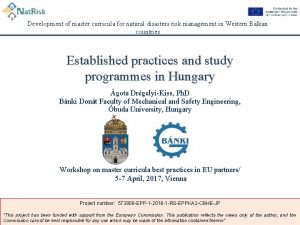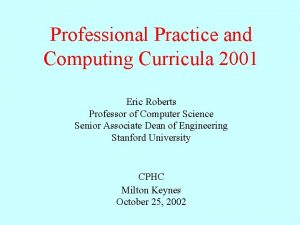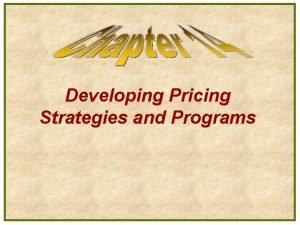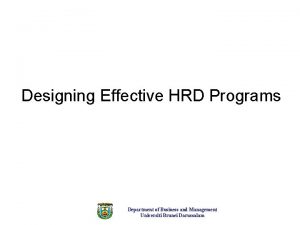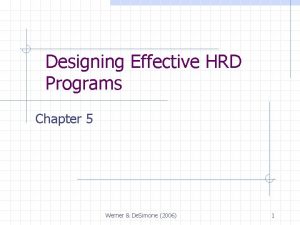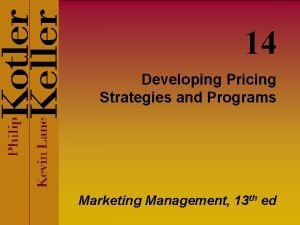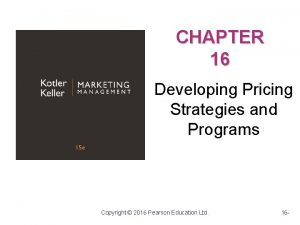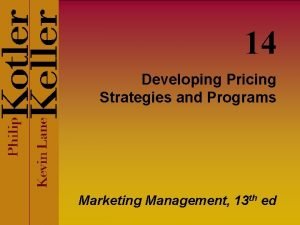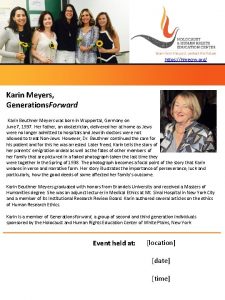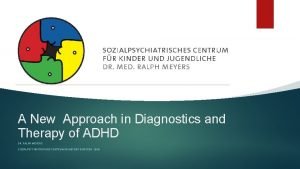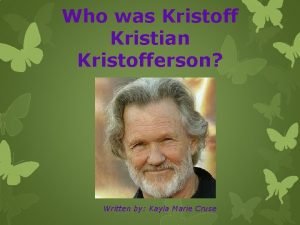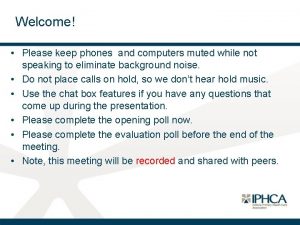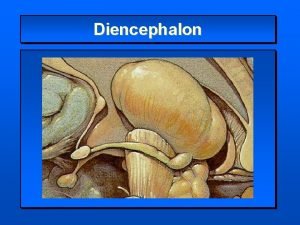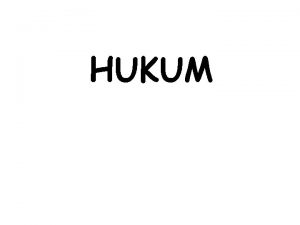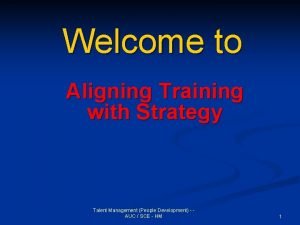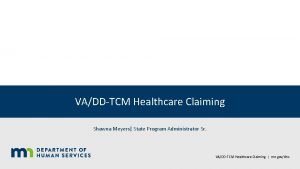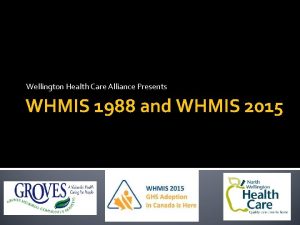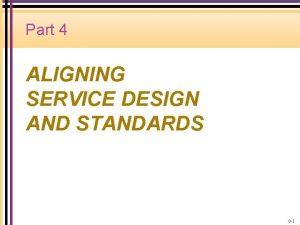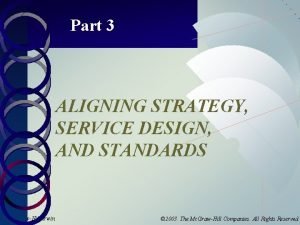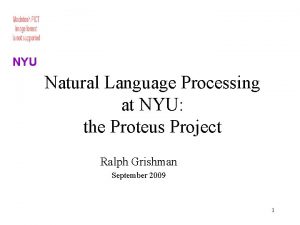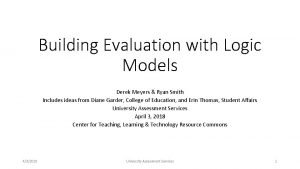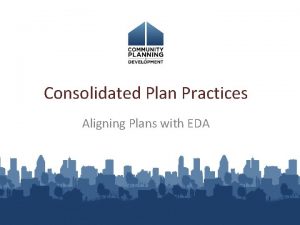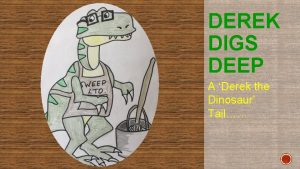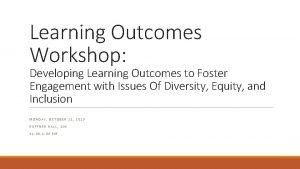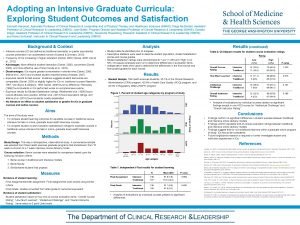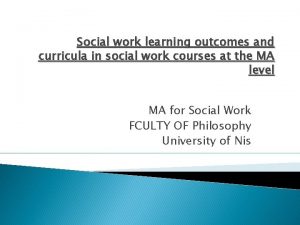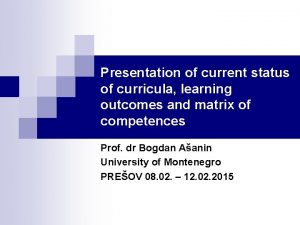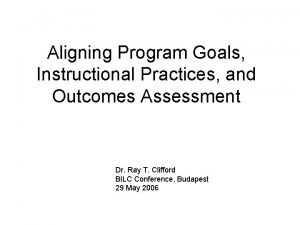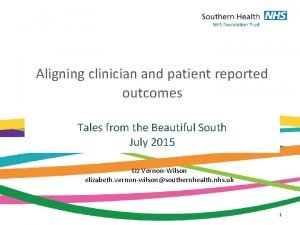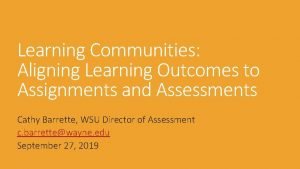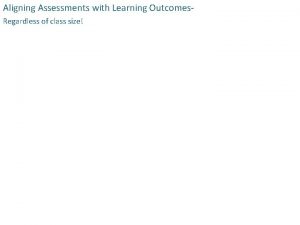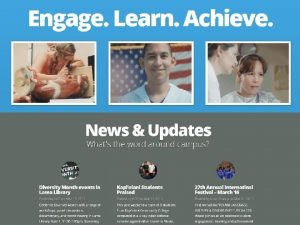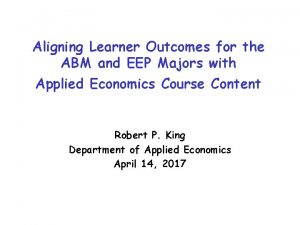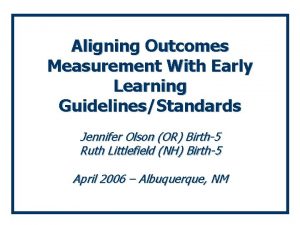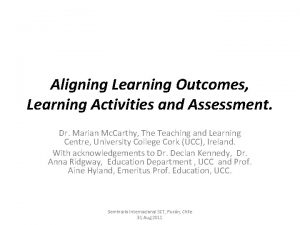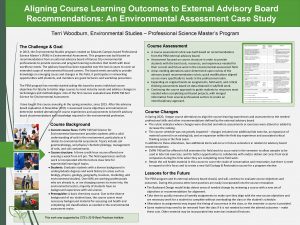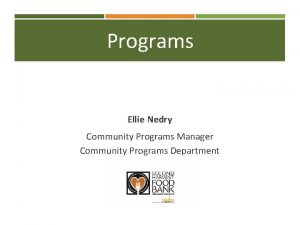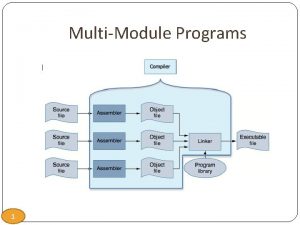Developing Aligning Outcomes with Curricula Programs Derek Meyers
























- Slides: 24

Developing & Aligning Outcomes with Curricula & Programs Derek Meyers & Ryan Smith University Assessment Services March 6, 2018 Center for Teaching, Learning & Technology Resource Commons 3/6/2018 University Assessment Services 1

Questions What is a curriculum? What should a curriculum include? What does a good curriculum look like? 3/6/2018 University Assessment Services 2

Our Experience

Students’ Experience

Alignment Is how & where students learn just as important as what students learn? Alignment = curriculum + instruction + assessment A blueprint An articulation of where and how learning occurs. A tool for aligning courses with goals or outcomes, or intentions with actions. 3/6/2018 University Assessment Services 5

Basic Curriculum Map Common Courses 111 GOALS OR OUTCOMES Goal 1 392 3/6/2018 X X X 340 X X X Goal 4 X X 231 331 Goal 3 X 138 200 Goal 2 X University Assessment Services X X X 6

Basic Co-curriculum Map GOALS OR OUTCOMES Units Campus Dining Health & Wellness X X Campus Housing X Campus Recreation X Student Organizations Student Health Services X Career Center 3/6/2018 Identity Development Civic Responsibility Global Awareness X X University Assessment Services 7

Assessment Map: Assessments in Cells OUTCOMES COMMON PROGRAM COURSES Outcome 1: Analyze and identify materials from which historical period they are made Outcome 2: Analyze the Outcome 3: Design and conservation needs of an administer a museum object budget. Art History 101 Common Exam questions Art History 110 Internship Attendance at college art events Art History 490: senior capstone 3/6/2018 Common Exam questions Museum Admin. Evaluation Term Paper Outcome 4: Develop appropriate research skills Term Paper Final Project University Assessment Services Final Project 8

Assessment Map: Activities in Cells OUTCOMES COMMON PROGRAM ASSESSMENT Common Exam Questions Outcome 1: Analyze and Outcome 2: Analyze identify materials from the conservation which historical period needs of an object they are made AH 101 Museum Admin. Eval. Term Paper College art events Final Project Rubric AH 490 3/6/2018 Outcome 3: Design and administer a museum budget. Outcome 4: Develop appropriate research skills AH 110 Internship College art events AH 490 University Assessment Services 9

Assessment Map: Co-Curricular OUTCOMES Units Campus Dining Campus Housing Campus Recreation Student Organizations Student Health Services 3/6/2018 Identity Development Health & Wellness Healthy Eating Initiative Evaluation EBI Survey Leadership Survey (Adv. Programs) Tracking Use NSSE Civic Responsibility Global Awareness Program Evaluation Patient Satisfaction and Follow-up Surveys University Assessment Services 10

Learning Environment Maps Prior Learning Required Courses Common Courses and Experiences Apply the scientific method Awareness of careers and job opportunities in biological sciences Work-based Learning Experiences Certifications & Licensures Possible Career Paths & Life Outcomes x Learningidentified Experiences x Develop laboratory techniques Diagram and explain major cellular processes Recommended Electives Activities and Experiences that Support Learning Outcomes (cocurricular) x x x From Jankowski, N. , & Marshall, D. (2017). Degrees That Matter: Moving Higher Education into a Learning Systems Paradigm. Sterling, VA: Stylus. 3/6/2018 University Assessment Services 11

Degree Level Maps Common Courses and Experiences Apply the scientific method General Education Major Courses x Develop laboratory techniques Diagram and explain major cellular processes Activities & Experiences Possible Career Paths & that Provide Support Life Outcomes (Co-curricular) x x Awareness of careers and job opportunities in biological sciences x x x From Jankowski, N. , & Marshall, D. (2017). Degrees That Matter: Moving Higher Education into a Learning Systems Paradigm. Sterling, VA: Stylus. 3/6/2018 University Assessment Services 12

Developmental Maps Program Learning Outcomes Awareness of careers Diagram and explain and job opportunities in major cellular processes biological sciences Apply the scientific method Develop laboratory techniques BIOL 101 Introduced BIOL 202 Developed Introduced BIOL 303 Developed Mastered Developed BIOL 404 Mastered Developed Assessed Common Courses and Experiences Other: Exit interview 3/6/2018 University Assessment Services 13

Developmental Maps OUTCOMES Identity Development Health & Wellness Civic Responsibility Global Awareness Campus Dining Low Emphasis High Emphasis Medium Emphasis Low Emphasis Campus Housing High Emphasis Low Emphasis Campus Recreation Medium Emphasis High Emphasis Low Emphasis Student Organizations Medium Emphasis High Emphasis Low Emphasis Student Health Services Low Emphasis High Emphasis Low Emphasis Campus Quidditch Program Low Emphasis Units 3/6/2018 University Assessment Services 14

Winberg, C. (2016). I Take Engineering with Me: Epistemological Transitions across an Engineering Curriculum. Teaching in Higher Education, 21, 398 -414. 3/6/2018 University Assessment Services 15

Veltri, N. , et al. (2011). Curriculum as a Tool for Continuous Improvement of Information Systems Curriculum. Journal of Information Systems Education, 22, 31 -42. 3/6/2018 University Assessment Services 16

Miller, M. , & Neyer, N. (2016). Mapping Information Literacy and Written Communication Outcomes in an Undergraduate Nursing Curriculum: A Case Study in Librarian-Faculty Collaboration. 3/6/2018 University Assessment Services 17

Harris, M. , & Patten, K. (2015). Using Bloom’s and Webb’s Taxonomies to Integrate Emerging Cybersecurity Topics into a Computing Curriculum. Journal of Information Systems Education, 26, 219 -234. 3/6/2018 University Assessment Services 18

Reading the Map: Example 1 COMMON PROGRAM COURSES & ACTIVITIES Art History 101 Outcome 1: Analyze and identify materials from which historical period they are made OUTCOMES Outcome 2: Analyze Outcome 3: Design and the conservation administer a museum needs of an object budget. X X Art History 110 X X Internship X Attendance at college art events Art History 490: senior capstone 3/6/2018 Outcome 4: Develop appropriate research skills X X X University Assessment Services X 19

Reading the Map: Example 2 Program Learning Outcomes Courses and Experiences Apply the scientific method Develop laboratory techniques Awareness of careers Diagram and explain and job opportunities in major cellular processes biological sciences BIOL 101 Introduced BIOL 202 Developed Introduced BIOL 303 Developed BIOL 404 Mastered BIOL 454 3/6/2018 Mastered University Assessment Services 20

Reading the Map: Example 3 OUTCOMES Units Campus Dining Campus Housing Campus Recreation Student Organizations Student Health Services 3/6/2018 Identity Development Health & Wellness Civic Responsibility Healthy Eating Initiative Evaluation EBI Survey Leadership Survey (Adv. Programs) Tracking Use Global Awareness Social Media Use Survey NSSE Patient Satisfaction and Follow-up Surveys University Assessment Services Annual Textbook Cost Survey 21

Benefits Clarifies relationship between teaching and learning Helps plan in the context of outcomes, as opposed to activities or processes Helps develop ideas for new activities or new program implementation Helps eliminate unproductive or unhelpful activities or assessments Shows faculty and staff how their area contributes to what students learn at the major level Fosters collegiality, sharing, and dialog 3/6/2018 University Assessment Services 22

Suggestions Emphasize that alignment is not about standardization. Engage in dialog with colleagues. Realize that maps take time and are continuous (wikimaps). Share maps with students. Avoid over-xing 3/6/2018 University Assessment Services 23

References • Allen, M. (2004). Alignment (Ch. 3 in Assessing Academic Programs in Higher Education). Bolton, MA: Anker. • Archambault, S. , & Masunaga, J. (2015). Strategic Planning & Assessment. J. of Library Admin. , 55, 503 -519. • Britton, M. , et al. (2008). A Curriculum Review and Mapping Process Supported by an Electronic Database System. American J. of Pharmaceutical Ed. , 77. • Buchanan, H. , et al. (2015). Curriculum Mapping in Academic Libraries. New Rv. of Academic Librarianship, 21, 94 -111. • Cuevas, N. , Matveev, A. , & Miller, K. (2010). Mapping General Education Outcomes in the Major. Peer Review, 12, 10 -15. • Harris, M. , & Patten, K. (2015). Using Bloom’s and Webb’s Taxonomies to Integrate Emerging Cybersecurity Topics into a Computing Curriculum. J. of Info. Systems Ed. , 26, 219 -234. • Jankowski, N. , & Marshall, D. (2017). Degrees That Matter: Moving Higher Education into a Learning Systems Paradigm. Sterling, VA: Stylus. • Lam, B. , & Tsui, K. (2016). Curriculum Mapping as Deliberation. Studies in Higher Ed. , 41, 1371 -1388. • Massa, L. , & Kasimatis, M. (2017). Curriculum & Outcome Mapping (Ch. 4 in Meaningful & Manageable Program Assessment). Sterling, VA: Stylus. • Miller, M. , & Neyer, N. (2016). Mapping Information Literacy and Written Communication Outcomes in an Undergraduate Nursing Curriculum. • Suskie, L. (2017). Assessing Student Learning: A Common Sense Guide. San Francisco: Wiley. • Toral, S. , et al. (2007). An Electronic Engineering Curriculum Design Based on Concept-Mapping Techniques. Int. J. of Tech. & Design Ed. , 17, 341 -356. • Veltri, N. , et al. (2011). Curriculum as a Tool for Continuous Improvement of Information Systems Curriculum. J. of Info. Systems Ed. , 22, 31 -42. • Watts, L. , & Hodgson, D. (2015). Whole Curriculum Mapping of Assessment: Cartographies of Assessment & Learning. Social Work Ed. , 34, 682 -699. • Williams, J. , & Bolland, K. (2011). Mapping Our Way to Success. Journal of Baccalaureate Social Work, 16, 39 -114. • Winberg, C. (2016). I Take Engineering with Me: Epistemological Transitions across an Engineering Curriculum. Teaching in Higher Ed. , 21, 398 -414. • Zelenitsky, S. (2014). Using Curriculum Mapping to Engage Faculty Members in the Analysis of a Pharmacy Program. Am. J. of Pharmaceutical Ed. , 78, 1 -9. 3/6/2018 University Assessment Services 24
 Curricula
Curricula Curriculum in plural form
Curriculum in plural form Computing curricula 2001
Computing curricula 2001 Definition of hidden curriculum
Definition of hidden curriculum Segmented pricing
Segmented pricing Hrd design
Hrd design Designing effective hrd programs
Designing effective hrd programs Developing pricing strategies and programs
Developing pricing strategies and programs Developing pricing strategies and programs
Developing pricing strategies and programs Developing pricing strategies and programs
Developing pricing strategies and programs Karin meyers
Karin meyers Opatus cpta
Opatus cpta Opatus test
Opatus test Lisa meyers children
Lisa meyers children Pia meyers md
Pia meyers md Vpm
Vpm Meyers straelen
Meyers straelen E.m. meyers
E.m. meyers Aligning training with strategy
Aligning training with strategy Shawna meyers
Shawna meyers Aligning hr strategy with business strategy
Aligning hr strategy with business strategy Whmis 2015 pictograms
Whmis 2015 pictograms Aligning service design and standards
Aligning service design and standards Aligning service design and standards
Aligning service design and standards Nyu nlp
Nyu nlp
